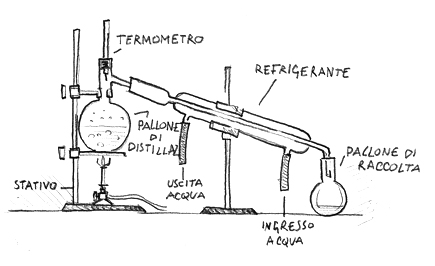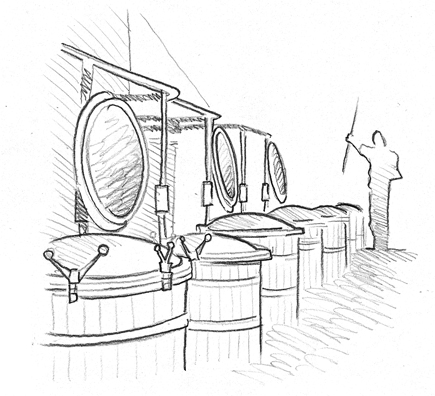|
THE DISTILLATION
Grappa comes from the distillation of pomace, grape skins that is a solid substance, which may or may not be allowed to ferment before processing. The process of distillation begins by filling up the distiller's cauldron with fermented grape's pomace, and then the cauldron is being warmed. This first phase allows the evaporation of liquid substances from the solid matter, mainly alcohol and water. In grappa’s case, the pomace contained in the distiller's cauldron starts boiling at 78,4° C that is the boiling point of the ethylic alcohol:the mail substance in a distilled beverage. As the alcohol in pomace is mixed with water, the boiling point will be higher and it will vary according to the percentage of water in the mixture as well as of alcohol. The pomace to be distilled also contains other components which evaporate when heated and are transferred to the distilled liquid. Many of these substances are unpleasing, therefore unwanted, and they will be removed or excluded. This process of separation, or elimination of bad and unwanted components is called “cutting out heads and tails”. The HEAD part is the very first liquid coming out from the distillation process and it is mainly made of bad and unpleasant components, that would give a vinegar taste to grappa as well as coarse aromas, and it also contains methyl alcohol, which is toxic, and therefore it is eliminated. The HEART is the middle part of the distillation, rich in ethyl alcohol and pleasant aromatic substances from which Grappa is obtained. The TAIL is the last part of the distillate which will be eliminated from the Grappa, since it contains unpleasant fatty and oily substances that evaporate at 95°. At the end of the distillation process, the grappa has a high quantity of alcohol, usually from 65% to 75%. The next step is to lower the alcohol's percentage through adding distilled or demineralized water, this percentage can be from 38% to 60%. Because of some insoluble substances contained in the distilled liquid, adding water will turn it turbid, giving it a “milky” and opaque aspect. As the grappa must be transparent and crystalline in color, it must be filtered in order to eliminate these insoluble components. The filtration process also eliminates other coarse and unwanted substances as well as some insoluble oils. To make the filtration process easier, grappa is chilled to a very low temperature, usually ranging from -10° C to -20° C and then filtered. When the filtration process is done, grappa is finally ready to be bottled or aged in wood according to the type the producer wanted to make. L |
|
(0) Items


